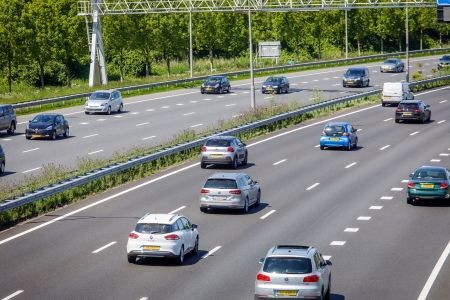Three factors may make electric cars less safe than cars with a combustion engine: lower sound intensity, risk of fire because of the battery, and a higher weight.
Lower sound intensity
Sound – particularly for cyclists and pedestrians – is an important factor in noticing other road users that are outside one’s field of vision or that are less visible due to fog and darkness [43] [44] [45]. A literature survey shows that electric vehicles are more silent than cars with a combustion engine at speeds up to 20 or 30 km/h [46]. Above this speed, no differences in sound intensity were found, probably because the tyres made more noise than the engine.
Since 1 July 2021, all new hybrid and fully electric vehicles in the European Union have had to be fitted with an Acoustic Vehicle Alerting System (AVAS), or artificially added sound at a forward speed up to 20 km/h and when reversing [47]. A field study illustrates that AVAS makes silent electric vehicles more noticeable to cyclists and pedestrians [48]. Yet, the EU guideline warrants some comment: it does not prescribe what the alerts should actually sound like, which allows car manufacturers some design scope and offers drivers different options, although this could imply that other road users may fail to recognise the sound [49] [50].
Risk of fire because of battery
Crash figures do not allow us to determine whether fire was the cause of a road crash injury. Nevertheless, compared to cars with a combustion engine, the batteries of electric cars increase the risk of fire. In extreme heat or cold, even though rare in the Netherlands, the risk of the battery catching fire increases [51]. In addition, in a crash in which large speed differences are a factor, the battery may get damaged and thus catch fire [51].
Extinguishing the fire is also different for electric cars compared to cars with a combustion engine. Since the extinguishing agents cannot reach the inside of the battery, it may re-ignite even days after the crash, unless it is sufficiently cooled (NTSC, 2018 in Sun et al. [51]).Therefore electric cars pose an additional danger to those having to extinguish the fire, or move, store or examine the vehicle.
Higher weight of electric cars
In a crash, a vehicle with a greater mass will cause severer injuries for the crash opponent than a vehicle with a smaller mass [52]. Figure 3 shows the average mass of cars involved in a fatal crash or serious-injury crash in 2009-2019 [i]. for three types of fuel. This shows that, during this period, the average mass of (hybrid) electric cars increased and that between 2014 and 2019 their average mass exceeded that of cars running on petrol or diesel. On the basis of a study by Berends [52] and if the trend in Figure 3 continues, we may assume that the average outcome of crashes will be more severe in crashes involving a relatively new electric vehicle.
Figure 3. Average mass of cars involved in fatal crashes and injury crashes in 2009-2014, irrespective of crash opponent.[i] Hybrid vehicles are included in the ‘electricity’ category. Source: BRON
[i] To allow comparison of cars with different energy sources, we only look at cars that were less than 6 years old at the time of the crash. This reduces the risk of comparing vehicles with and without (advanced) vehicle safety systems. Crashes of cars that were powered by LPG, natural gas, or alcohol were left out because of the few crash-involved cars using these fuel types.
